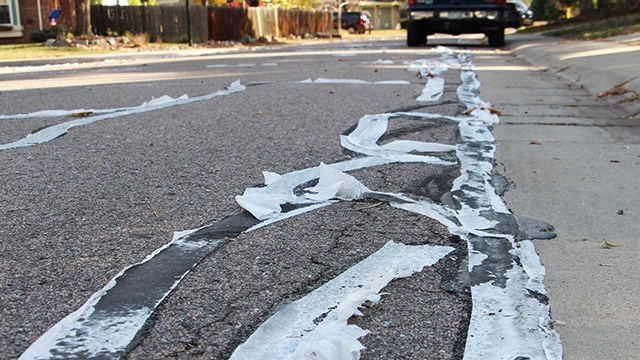Papering over the cracks – with toilet paper
This week, bewildered residents in Littleton, Colorado, USA, were left wondering why local highways crews were leaving toilet paper strewn all over the roads behind them!
The city’s street and traffic operations division were carrying out crack sealing works on 120 roads, a basic preventative maintenance measure to seal pavement cracks that have developed due to expansion and contraction caused by temperature fluctuations, which is very common in regions that experience the extremes of cold and hot weather. Crack sealing maintenance extends the life of roadways and parking areas paved with either asphalt or concrete by an estimated 10 years and is much cheaper than conventional pavement rehabilitation or reconstruction.
Crack sealing uses either hot or cold-applied tar sealants to minimise water penetration and stop sub-surface ice from forming. If allowed to spread unchecked cracks allow water to penetrate the asphalt pavement into the base and sub-base material layers, causing the pavement to lose structural integrity, leading to deformation, pot holes and then the degradation of the asphalt wearing course or concrete surfaces. Once cracks have spread the area must be cut out and replaced or patched.
So why use toilet paper?
Using toilet paper in road construction is one of those ideas that seems preposterous until you realise the genius behind it.
The bituminous materials used to seal the cracks are really sticky and depending on the weather take about 40 minutes to set. By placing a protective and absorbent covering over the exposed sealant, pedestrians, bicycles and vehicular traffic can access the road or pavement immediately, without the tar sticking to people’s shoes or car tyres, which then makes an unsightly and tacky mess of the surrounding area. This means highways departments do not have to close the road to do the crack sealing.
Single-ply toilet paper is commonly used as it’s cheap and it’s 100% biodegradable. Unlike heavier kinds of paper, it meshes easily with the sealant and is usually gone in a day or two. Over the years a number of blotting products have been experimented with, but toilet paper has yet to be improved upon, and can be applied using a simple paint roller.
According to the 2014 Colorado Department of Transportation Hot Mix Asphalt Crack Sealing and Filling Best Practices Guidelines: “a material may be needed to reduce or minimize tracking of the sealant by vehicle tires. Common blotting materials include toilet paper, talcum powder, limestone dust, sand, or proprietary, spray-applied detackifiers.
The concept was the brainchild of Fred Muellerleile, who worked for the Minnesota Department of Transportation for 33 years. He won an award for this idea in 1970.

“It’s always handy to have a supply of Toilet paper on hand, whatever the job!”




















